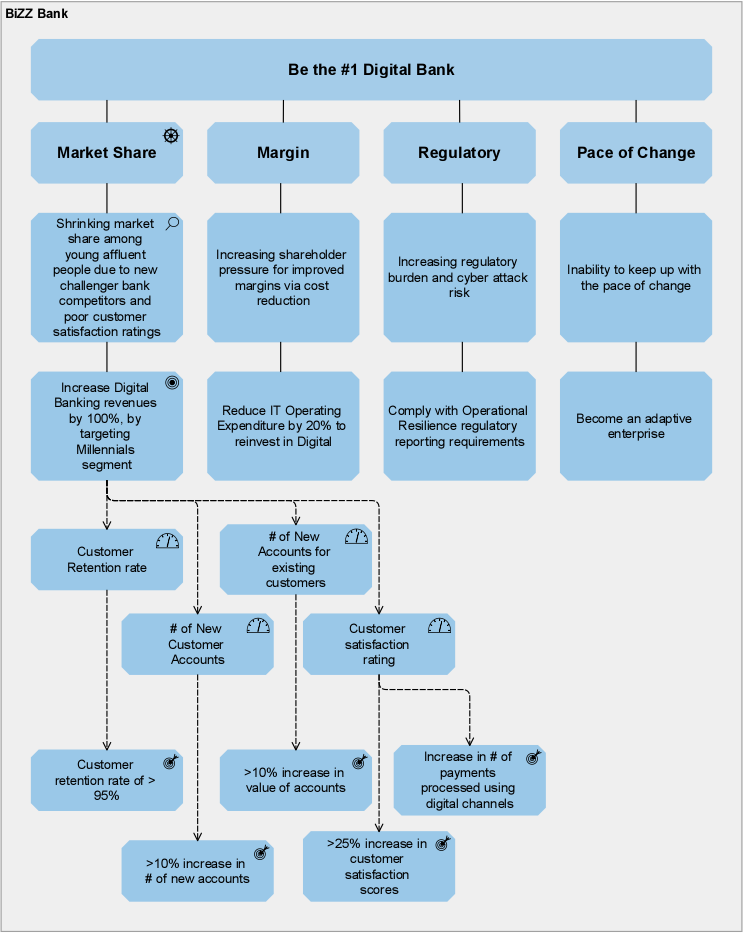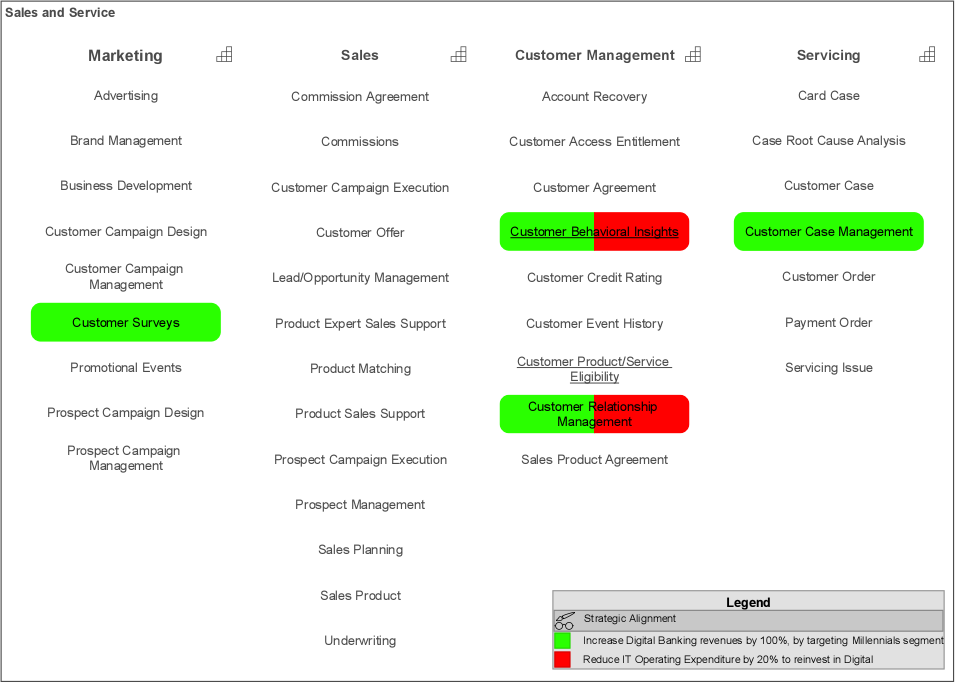Digital transformation initiatives are relatively commonplace these days. That’s because there is a pretty wide understanding that you can’t really keep doing what you’ve been doing and expect to be successful in the long run – not with technology advancing so quickly, consumers being so demanding, and a rapidly falling barrier to entry. That much organizations have internalized.
KPIs set the stage
Something that’s not so well understood, and one of the reasons why many of these digital transformation initiatives often resemble a knee-jerk reaction, is the failure to formulate clear digital KPIs. As with any endeavor, key performance indicators are needed during a business change event because they offer explicit avenues along which to focus work.
Putting KPIs together results in a game plan, which – much like a force field in physics – helps to orient all activities of the enterprise with the main goal. In certain situations, KPIs may even pull in different directions, requiring some extra work to pull off the balancing act required to reach an equilibrium in the approach. However, once done, it significantly facilitates progress. On the ground, this means that the projects that get proposed and approved; the investments in people and technology; as well as the high-level strategic decisions – they all actively support the achievement of the overarching goal.
How do you set relevant KPIs?
Now imagine an organization that didn’t just embark on a transformation journey overnight, meaning they are genuinely concerned with the outcome. So, being responsible, they wish to set up digital KPIs – but that’s anything but simple. Especially for traditional enterprises who may be going through their first large-scale digital undertaking. So how do they go about it?
Well, one option is to emulate what other organizations are doing. In this instance, the kind of information that the team driving the initiative is exposed to dictates, to a certain degree, the final outcome. Specifically, if the ‘case study company’ features organizational variables that mirror those of the ‘apprentice company’, there is a good chance that a lift-and-shift approach will be successful. On the other hand, should the two organizations share only a few to no real similarities, then it is unlikely the exercise will produce the desired outcome.
This is the problem with option one, i.e., looking at what the neighbor is doing and then trying to reproduce their approach wholesale. It’s really hit or miss. That’s why, for instance, dashing down the same road that a competitor’s been cruising on for a while generally doesn’t work. If they’re successful at it, it’s probably because a certain amount of thought and care went into that project. Whereas you, the late starter, are fueled by a fear of missing out. The bottom line is that while borrowing insights and expertise with little to no tailoring may work for ‘par for the course’ initiatives (where no major competitive advantage is gained), it is unlikely to yield results in scenarios where these borrowed ideas are supposed to bring about significant positive change.
Every organization is the sum of many different internal and external vectors, as well as unique characteristics. As such, they each require a digital transformation program that suits them specifically, with digital KPIs to reflect this. And that’s how we come across option two, which is looking inside to try and identify the most relevant digital KPIs. Taking a long hard look at the makeup of the company and deriving a strategy along with tactics and metrics that share their DNA with the organization they’re supposed to turn around. Naturally, this requires a good more deal of knowledge and perseverance, as you drop the ‘golden recipe’ approach and plunge into some serious organizational soul-searching.
Enterprise architecture guides the selection of digital KPIs
This is where enterprise architecture comes in. Let’s have a look at how EA supports organizations that want to leverage digital KPIs to increase their digital transformation’s probability of success.
1. Define a digital goal
The first step, if you’re taking the digital KPIs route, is to settle on a clear digital goal, e.g. fully digitizing the customer experience for transitioning from one financial product (an entry-level debit card) to another (a premium card that offers certain benefits). This ensures you won’t waste any time and resources chasing the wrong rabbit. EA plays a major role at this point because it provides a comprehensive view of the company’s business and IT landscapes. Therefore, the team spearheading the transformation efforts can access reliable information on how the business layer with its capabilities, processes etc. interacts with – and is indeed supported by – the application and technology layers. Here is another example in the visual below, this time illustrating an Increase Digital Banking revenues by 100% by targeting millennials goal, which is further decomposed into digital KPIs.

Also, here is another visual created in Horizzon below that illustrates how this aligns with another goal to Reduce IT Operating Expenditure by 20% to Reinvest in Digital.

Taking a step further into this direction, it wouldn’t be a stretch to imagine this being connected at the top to the strategy and business model side of things. If the initiative is truly transformative, it must be strategic as well. On the more operational side, EA could shed some light into the processes that are currently in place, highlighting where the most acute problems are, or where most value-add lies – important things to know as you set out to ‘remodel’ the organization.
Of course, the more granular the preoccupation the less it would come into play at this stage, and the farther outside the scope of architecture it would straggle. But, depending on the specifics of the scenario, these may be relevant even at an early stage. In any case, it’s safe to say that at this point EA will help you turn a somewhat poorly defined grievance into a clear objective.
2. Identify relevant metrics
Once you have settled on a digital goal, you suddenly have a better idea of what you ought to monitor – inadvertently, an initial metrics selection takes place. Now you can further refine this list and get it down to a more manageable size, with more relevant content. A good approach would be to try and include metrics that resonate with both internal stakeholders (from the business and IT side) and customers. So, for example, feature elements that would make the Chief Enterprise Architect (or Chief Operations Officer) happy – metrics around the rate of progress of digitization initiatives within different departments; the digitalization of the workplace; improved collaboration between employees; automating processes etc. But be sure to also include ones that would please the CFO, such as metrics relating to an increase in the bottom line via digitalization – new revenue facilitated by new digital
capabilities, a lower churn rate, a higher lifetime customer value etc. That accounts for people inside the company. Now think of your audience, and how their interests might be represented here, and you have a solid group of metrics to work with. By the way, if you’re interested in learning more about customer centricity go ahead and read our previous blog post.
In this instance, too, enterprise architects prove valuable. Acting as a liaison between management and operational roles, they can ensure the proposed metrics are connected to the business reality. Are executives providing business feedback that is incompatible with metrics used to measure IT infrastructure and applications? Maybe application owners are unresponsive to how application performance is impacting business performance. Whatever it may be, if there’s a group that can provide an integrated view on the inner workings of the enterprise and make opposing camps find common ground, that’s architects.
3. Select the digital key performance indicators
Having a solid landscape of relevant metrics means you are well-positioned for homing in on your digital KPIs. More than at any other point, this is a time to collaborate with management. And again, EA plays a vital role because it helps produce clear, useful business cases for whatever the target of digitalization might be, which then helps to inform the choice of key performance indicators.
You could cross-link your KPIs to more traditional ones such as those for a Balanced Scorecard or create a kind of ‘Digital Scorecard’ to provide management with insights. Importantly, having clear objectives (as in a subset of the main umbrella-goal) leads to a better articulated list of benefits, when discussing desired outcomes. Clear objectives, with facts and figures, can’t be pulled out of thin air, though. They need to be corroborated with the reality of the IT backend, for instance, or the availability/limitations of certain business services and interfaces. This is yet another area where the visibility afforded by architectural insights will prove beneficial.
Ultimately, you have to remember that there is a large degree of freedom when defining key performance indicators, but as long as you keep them business impact focused, clear, and measurable, you’ll end up with a relevant set of digital KPIs.
4. Monitor, reassess, improve This fourth bullet point is dedicated to ‘continuous improvement’. That’s because irrespective of how well you plan and prepare, there are certain aspects of any project that only become apparent with time. In this case, EA keeps track of the direction and progress of change, offering a reliable record of the initiative at various stages in time. Checking that against the KPIs or other unforeseen developments provides a background for analysis, and possible opportunities to course correct. You can even imagine spotting trends and making forecasts based on these measurements. That will let you proactively carry out changes, before the immediate need arises. Experience might point towards the fact that a certain KPI is not as valuable as you believed, or in fact you might identify a new KPI that makes a lot of sense but wasn’t spotted initially. To track and keep tabs on the progress of a digital transformation program effectively, you need to be willing to change these – the things you measure need to evolve as well! Enterprise architecture makes knowing what you are trying to achieve and what to track more evident, more quickly.
Conclusion
To conclude, digital transformation initiatives are not only complex affaires, but also very particular. As such, their success depends closely on how accurately they reflect the unique reality of the enterprise, and therefore how relevant the performance indicators that are selected to drive and measure progress are. Since this boils down to deep knowledge of the organization, enterprise architecture stands out as the go-to solution for defining and assessing the best possible digital KPIs.
In fact, during such important programs, architects have the opportunity and indeed the responsibility to act as a first-tier advisory function to management. With their background in technology and business, and leveraging the key insights they produce, enterprise architects can ensure management get all the support they need in order to formulate a fact-based strategy forward. To learn more about architecture’s role in facilitating digital transformation, read our Building a Digital Twin of Your Organization blog post, it’s packed with interesting information!